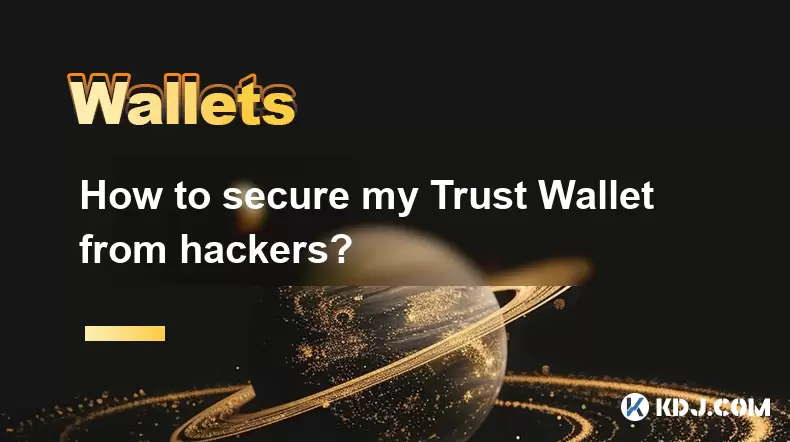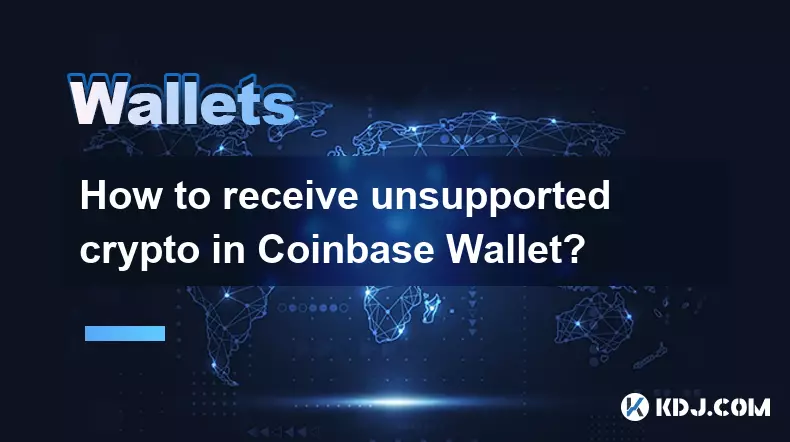-
 bitcoin
bitcoin $114206.058833 USD
-0.82% -
 ethereum
ethereum $4129.796871 USD
-1.31% -
 tether
tether $0.999964 USD
0.00% -
 xrp
xrp $2.640265 USD
-0.68% -
 bnb
bnb $1141.700384 USD
-0.18% -
 solana
solana $200.380665 USD
-2.05% -
 usd-coin
usd-coin $0.999888 USD
0.01% -
 dogecoin
dogecoin $0.200706 USD
-3.43% -
 tron
tron $0.299112 USD
-0.60% -
 cardano
cardano $0.668491 USD
-2.72% -
 hyperliquid
hyperliquid $46.924669 USD
-2.72% -
 chainlink
chainlink $18.286013 USD
-2.66% -
 bitcoin-cash
bitcoin-cash $555.734639 USD
-0.58% -
 stellar
stellar $0.323999 USD
-2.74% -
 ethena-usde
ethena-usde $0.999169 USD
0.00%
How to secure my Trust Wallet from hackers?
Secure your Trust Wallet with biometric authentication, offline recovery phrases, and regular updates to protect against hackers and phishing scams.
Jul 03, 2025 at 01:21 am

Understanding the Importance of Securing Your Trust Wallet
Trust Wallet is one of the most popular non-custodial cryptocurrency wallets, allowing users to store, manage, and interact with their digital assets securely. However, as its usage grows, so does the interest of malicious actors looking to exploit vulnerabilities. Securing your Trust Wallet from hackers is crucial because any breach could lead to irreversible loss of funds. Since Trust Wallet gives you full control over your private keys, the responsibility of safeguarding them lies entirely with you.
Enabling Biometric Authentication for Enhanced Security
One of the first lines of defense in securing your Trust Wallet is enabling biometric authentication. This feature ensures that only you can access your wallet using fingerprint or facial recognition, depending on your device's capabilities. Here’s how to set it up:
- Open the Trust Wallet app
- Navigate to Settings
- Tap on Security & Privacy
- Enable Biometric Login
This step adds a critical layer of protection by ensuring that even if someone gains physical access to your phone, they cannot open your wallet without your unique biometric data.
Safeguarding Your Recovery Phrase
The recovery phrase, also known as the seed phrase, is the most sensitive piece of information associated with your Trust Wallet. It acts as a master key to all your funds and must be kept offline and secure at all times. Here’s what you should do:
- Never store your recovery phrase digitally, including cloud storage, notes apps, or screenshots
- Write it down on paper and store it in a safe, fireproof location
- Consider using a metal backup solution designed for cryptographic phrases
- Avoid sharing it with anyone, including people claiming to be support staff
Failure to protect this phrase could result in complete loss of access to your digital assets if it falls into the wrong hands.
Avoiding Phishing Scams and Malicious Links
Phishing remains one of the most common tactics used by hackers to steal cryptocurrency. Scammers often impersonate Trust Wallet or other legitimate services through fake websites, emails, or social media messages. To avoid falling victim:
- Always verify the URL when accessing Trust Wallet’s official website — ensure it is trustwallet.com
- Do not click on links sent via unsolicited messages, even if they appear to come from trusted sources
- Be cautious of offers promising free tokens or urgent account verification requests
- Install reputable security software on your mobile device to detect and block malicious sites
By staying vigilant and questioning the legitimacy of unexpected communications, you significantly reduce the risk of being scammed.
Regularly Updating the Trust Wallet App
Keeping your Trust Wallet application updated is essential for maintaining a high level of security. Developers frequently release updates to patch vulnerabilities, improve performance, and add new features. Here’s how to stay current:
- Check your device’s app store regularly for Trust Wallet updates
- Enable automatic updates if your device supports them
- Review changelogs to understand what improvements have been made
Outdated versions of the app may contain known security flaws that hackers can exploit, so timely updates are vital for protecting your wallet against emerging threats.
Using Trusted Networks and Devices
The network and device you use to access your Trust Wallet play a significant role in its overall security. Public Wi-Fi networks, for example, are notorious for being insecure and prone to eavesdropping. To minimize risks:
- Avoid accessing your wallet while connected to public or unsecured networks
- Use a personal, password-protected mobile hotspot when necessary
- Ensure your device is protected with strong passcodes or biometric locks
- Refrain from jailbreaking or rooting your device, as it can introduce security weaknesses
Using a dedicated device solely for managing your cryptocurrency can further enhance security by minimizing exposure to potential malware or unauthorized access.
Frequently Asked Questions (FAQs)
Q: Can I change my recovery phrase in Trust Wallet?A: No, you cannot change your recovery phrase once it has been generated. The phrase is created during wallet setup and remains tied to your wallet address permanently. If you suspect it has been compromised, the safest course of action is to create a new wallet and transfer your funds.
Q: Is it safe to store large amounts of cryptocurrency in Trust Wallet?A: While Trust Wallet is secure, storing large sums of crypto always carries some risk. For enhanced safety, consider using hardware wallets like Ledger or Trezor for long-term storage and only keep smaller amounts in Trust Wallet for daily transactions.
Q: What should I do if my phone gets stolen?A: If your phone is stolen, immediately assess whether your wallet was protected with biometric authentication or a strong passcode. If yes, contact your service provider to suspend your SIM card and remotely wipe your device if possible. As long as your recovery phrase was not stored digitally or accessible to others, your funds should remain safe.
Q: Does Trust Wallet offer customer support for hacked accounts?A: Trust Wallet does provide support through its help center and email assistance. However, since it is a non-custodial wallet, the team cannot recover lost funds or reset passwords. You must rely on your recovery phrase and follow best practices to regain access if needed.
Disclaimer:info@kdj.com
The information provided is not trading advice. kdj.com does not assume any responsibility for any investments made based on the information provided in this article. Cryptocurrencies are highly volatile and it is highly recommended that you invest with caution after thorough research!
If you believe that the content used on this website infringes your copyright, please contact us immediately (info@kdj.com) and we will delete it promptly.
- Essex Post Office, 5p Coins, and King Charles: A Royal Mint Revelation!
- 2025-10-23 10:30:16
- Waymo's Newark Airport AV Tests: Alphabet's AI Gamble Pays Off?
- 2025-10-23 10:30:16
- King Charles 5p Coins: A Royal Flush in Your Pocket?
- 2025-10-23 10:35:18
- Solana, Crypto Advisory, and Forward Industries: A New York Minute on the Future of Finance
- 2025-10-23 08:51:22
- MAGACOIN: Ethereum Whales Dive into the Hottest Presale of 2025
- 2025-10-23 08:51:22
- Kadena's End of the Road? KDA Token Plummets Amid Project Abandonment
- 2025-10-23 08:55:34
Related knowledge

How to clear the cache for the Coinbase Wallet dApp browser?
Oct 27,2025 at 12:54pm
Understanding the Coinbase Wallet dApp Browser Cache1. The Coinbase Wallet mobile application includes a built-in dApp browser that allows users to in...

How to receive unsupported crypto in Coinbase Wallet?
Oct 25,2025 at 09:48am
Understanding Unsupported Cryptocurrencies in Coinbase Wallet1. Coinbase Wallet supports a wide range of cryptocurrencies, but not every token availab...

How to interact with smart contracts using Coinbase Wallet?
Oct 27,2025 at 12:00am
Connecting Coinbase Wallet to a dApp Interface1. Open the decentralized application (dApp) you want to interact with in your mobile browser or web bro...

How to solve connection issues with the Coinbase Wallet extension?
Oct 28,2025 at 12:02am
Troubleshooting Network and Browser Compatibility1. Ensure your browser is up to date. Older versions may lack support for modern Web3 protocols requi...

How to find a contract address for a token in Coinbase Wallet?
Oct 25,2025 at 12:09pm
Understanding Token Contract Addresses in Coinbase Wallet1. A contract address is a unique identifier for a specific token on a blockchain network. In...

How to switch between wallets in the Coinbase Wallet app?
Oct 27,2025 at 11:03pm
Understanding Wallet Management in Coinbase WalletThe Coinbase Wallet app allows users to manage multiple cryptocurrency wallets within a single inter...

How to clear the cache for the Coinbase Wallet dApp browser?
Oct 27,2025 at 12:54pm
Understanding the Coinbase Wallet dApp Browser Cache1. The Coinbase Wallet mobile application includes a built-in dApp browser that allows users to in...

How to receive unsupported crypto in Coinbase Wallet?
Oct 25,2025 at 09:48am
Understanding Unsupported Cryptocurrencies in Coinbase Wallet1. Coinbase Wallet supports a wide range of cryptocurrencies, but not every token availab...

How to interact with smart contracts using Coinbase Wallet?
Oct 27,2025 at 12:00am
Connecting Coinbase Wallet to a dApp Interface1. Open the decentralized application (dApp) you want to interact with in your mobile browser or web bro...

How to solve connection issues with the Coinbase Wallet extension?
Oct 28,2025 at 12:02am
Troubleshooting Network and Browser Compatibility1. Ensure your browser is up to date. Older versions may lack support for modern Web3 protocols requi...

How to find a contract address for a token in Coinbase Wallet?
Oct 25,2025 at 12:09pm
Understanding Token Contract Addresses in Coinbase Wallet1. A contract address is a unique identifier for a specific token on a blockchain network. In...

How to switch between wallets in the Coinbase Wallet app?
Oct 27,2025 at 11:03pm
Understanding Wallet Management in Coinbase WalletThe Coinbase Wallet app allows users to manage multiple cryptocurrency wallets within a single inter...
See all articles










































































